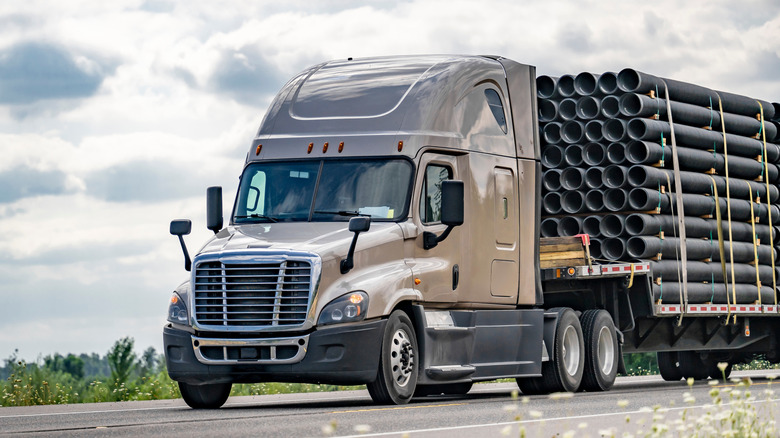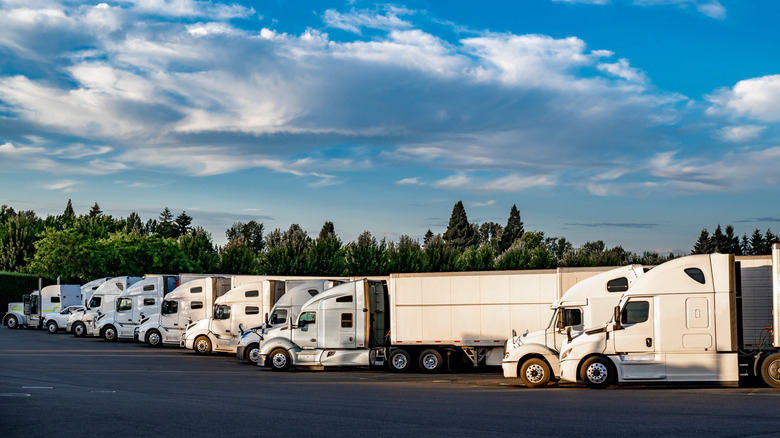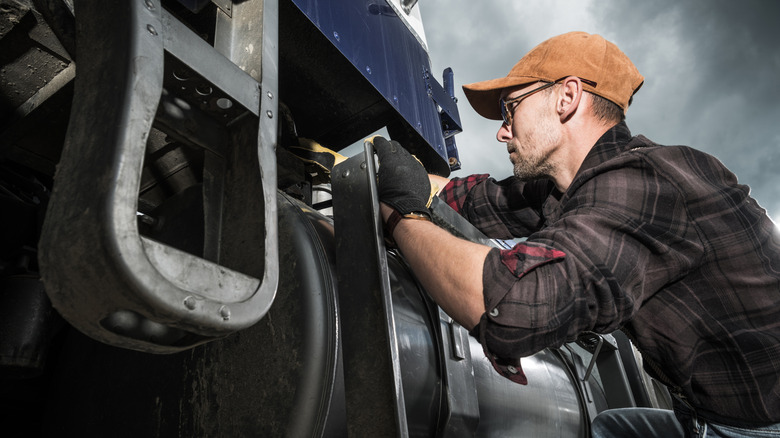What It Takes To Become A Trucker: Tests, Training, And More
According to a report by the American Transport Research Institute (PDF), more than 3.5 million people were working as truck drivers in America in 2024. A new stream of drivers is consistently required to replace those who leave the industry, and that means there are plenty of opportunities for newcomers to get into trucking. However, not every training opportunity is equal, and it's important to know the common pitfalls that trainees and newly qualified drivers can face.
From unscrupulous companies that lock employees into exploitative contracts to truckers burdened with significant debt, there are plenty of obstacles facing new arrivals to the trucking industry. SlashGear spoke to Desiree Wood, President of REAL Women In Trucking, about how best to tackle these common obstacles, as well as the additional issues that women joining the industry are likely to face.
The first step is getting a CDL
Obtaining a commercial driver's license, or CDL, is the first step to getting a job in the industry. It's important to carefully consider where you get your CDL, with Wood telling us, "there are many CDL training programs in the United States but very often they provide substandard training." She said, "Entry-level truck driver training has a very low barrier to entry but it also has a nearly 200% turnover rate during the training phase." REAL Women in Trucking (PDF) advises that it's always better to get a CDL from a community college program or a standalone CDL driving school, since there should be no restrictions on where you can get hired after you receive your license.
A community college program is the safest bet for receiving a good standard of training, and these programs can be cheaper than taking a private CDL course from a training school. However, they're often longer, taking around 8-16 weeks. A private CDL school can train you significantly faster, but its programs can also vary in quality. RWIT says that it's best to thoroughly research any training school you're looking at online before you apply. Wood added, "Stay away from CDL mills and company-sponsored training that is essentially employer-driven debt and substandard training. Student truck drivers are a source of cheap labor and new entrants must make smart choices the first year or they will just be used as a cheap labor source."
Don't be fooled by misleading advertisements
It's easy to come across advertisements promising fast learning and high earning potential, but Wood cautioned that these ads shouldn't be taken at face value. She said, "The first year is absolutely critical if you intend to become a qualified truck driver and that means ignoring the flashy ads that say you can make a lot of money." Despite some recruiters claiming that drivers will be able to make six-figure sums right away, Wood said that, "You won't be making much money during the first six months regardless of what [they] tell you."
"That means you must prepare to live a very Spartan existence. A lot of people don't make it six months in the industry because they are unprepared for the change to their lifestyle." To make it as a truck driver, RWIT encourages potential trainees to consider whether they're comfortable with the idea of being away from home for long periods of time, whether they handle stressful situations well, and whether they can manage their time with minimal supervision. Another key consideration is how well trainees cope with being alone, since a lot of time on the job can be spent without company once you qualify.
How the CDL test works
After you've enrolled in a program or picked a school to complete your CDL, you'll need to start preparing for the test. There are several distinct sections of the test, and your instructor should guide you through how each section works. Wood noted that, "You can [also] find study guides free on the internet to help prepare." The first section is a pre-inspection, which is intended to show the examiner that you can prove the truck is safe to drive. You'll need to demonstrate that you have a good understanding of the different parts of the truck, and that you can check that key components are in good, working order before you set off.
Once you've completed this initial section, you'll be subject to a vehicle controls section, which includes demonstrating your ability to safely perform maneuvers like backing the truck in a straight line, in a particular direction, or parallel parking. According to Wood, "You may have to do at least two different ones, or all of them."
The final section is a drive on public roads. To pass, Wood said, "You must be able to make your turns safely without hitting or bumping any curbs. The instructor will be watching you to see if you are using your mirrors properly [and checking] in your blind spots." If the examiner is happy with your performance in each section, you'll pass, and be issued a CDL.
Don't think that all you need is a CDL
It can be easy to assume that getting your CDL will mean that your training is complete, but that's far from the truth. "Even if you pass and are issued your commercial drivers license," Wood said, "you are still not considered qualified or insurable." Instead, "You will only have some basic skills at this point to operate a commercial motor vehicle. The next step is to choose a good starter company and that is where the difficulties really ramp up."
During your first weeks and months on the job, you'll likely be paired with a trainer. They'll guide you through tricky driving scenarios, and should also ensure that admin tasks like updating your truck's necessary information and documents are taken care of. You might end up living with your trainer on the truck, which Wood said "takes enormous skill and mutual respect." In most cases, she said, "You will likely not be qualified to drive locally right away and will instead be required to go "over the road" (OTR) until you are considered insurable." Even if local driving is your long-term plan, it's wise to assume you'll be OTR when you first start out.
Remember truck driving isn't for everyone
Truck driving has a high turnover rate, with plenty of rookie truck drivers leaving the industry due to the inherent pressures of the job. As previously mentioned, being a truck driver often means working alone for long periods of time and being responsible for managing both your time and the condition of your truck. When we asked about the sorts of people who made good long-haul semi-truck drivers, Wood was quick to point out that it "is one of the top ten most dangerous jobs to hold [and so] safety must be a core value." She continued, "It's no place for those who are just doing it for the cool factor."
Being choosy about your starter company can greatly improve your chances of sticking through your first few years in the job, but Wood notes that, no matter what, "If you want to become a truck driver, be prepared to work very hard the first year." Most new trucking recruits are male, with the ATRI noting that only 4.7% of truck drivers are women. Only 37% of those women possess the highest class of CDL license, Class A. Efforts are ongoing to get more women into the industry, although Wood cautions that there are several additional issues that female truck drivers may face.
Female truckers still face discrimination and assaults
The ATRI report concluded that encouraging more women to become truck drivers was a key part of maintaining a healthy workforce, but Wood said that female truckers still risk harassment and assault during their training. She said that, "Sexual predators [...] work frequently in starter companies [and] the industry for years has tried to sweep this under the rug." Instead of taking action to remove these predators, some companies "make women wait for training with a woman trainer." This can lead to much longer wait times for new female truckers, since there aren't many female trainers in the industry.
Even then, she said, "Same gender training doesn't guarantee you will not be subjected to sexual harassment, sexual assault, violence, and substandard unprofessional training." She advocates for a "complete overhaul" of industry training practices, but until then, RWIT has a "Get Help" webpage with further advice for female truckers who have been subject to harassment or abuse.
Beware of team driving and lease purchase trucks
Some trucking companies enforce team driving as part of their training programs, but it's generally advisable to stay away from team driving if possible. For female truckers, it can increase the risk of being subject to harassment or sexual assault, but even for males, it may not be a pleasant experience. It's not difficult to find horror stories on social media of new truck drivers having to share a cab with disrespectful or unhygienic colleagues, and that doesn't account for the potential safety issues of letting someone else drive while you're asleep in the back of the truck.
Companies that push new drivers into lease purchase trucks are also ideally worth avoiding, as they can push recruits into significant amounts of debt. Semi-trucks can last millions of miles, but they're also very expensive, with most new semi-trucks costing well over $100,000. RWIT advises that truckers should "do thorough research before you sign a training or lease purchase contract," as a bad contract could leave you with limited options should you wish to leave the industry.
Do your research to reap the rewards
While there are plenty of hurdles a new truck driver will have to overcome to gain a foothold in the industry, determined trainees shouldn't be put off by them. Wood said that, "Becoming a truck driver can be life changing but it is hard work," and that any new driver should expect "long hours and a lot of life humbling moments." Despite the lows, she said, "trucking can definitely make you a better person," and that successful trainees will be able to "ultimately tackle anything."
Age shouldn't be a barrier either, as the average semi-truck driver is in their late '40s, and plenty of drivers enter the profession after leaving a different career. So, if you're looking to get behind the wheel of an 18-wheeler, don't be discouraged by the demands placed on new drivers. Researching the best places to earn your CDL and the best starter companies in your area can make a huge difference to your experience, and taking advice from industry veterans can help you avoid the most exploitative companies.








